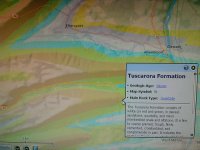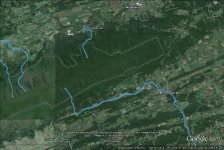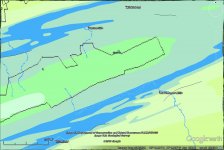right, very local effects of acid rain w/ geology. (I believe unimpaired streams have about 6.5 ph):
Sci Total Environ. 2008 Apr 15;393(2-3):249-61. doi: 10.1016/j.scitotenv.2007.12.026. Epub 2008 Feb 6.
"Groundtruthing and potential for predicting acid deposition impacts in headwater streams using bedrock geology, GIS, angling, and stream chemistry.
Kirby CS1, McInerney B, Turner MD.
Abstract
Atmospheric acid deposition is of environmental concern worldwide, and the determination of impacts in remote areas can be problematic. Rainwater in central Pennsylvania, USA, has a mean pH of approximately 4.4. Bedrock varies dramatically in its ability to neutralize acidity. A GIS database simplified reconnaissance of non-carbonate bedrock streams in the Valley and Ridge Province and identified potentially chronically impacted headwater streams, which were sampled for chemistry and brook trout. Stream sites (n=26) that originate in and flow through the Tuscarora had a median pH of 5.0 that was significantly different from other formations. Shawangunk streams (n=6) and non-Tuscarora streams (n=20) had a median pH of 6.0 and 6.3, respectively. Mean alkalinity for non-Tuscarora streams (2.6 mg/L CaCO(3)) was higher than the mean for Tuscarora streams (0.5 mg/L). Lower pH and alkalinity suggest that the buffering capability of the Tuscarora is inferior to that of adjacent sandstones. Dissolved aluminum concentrations were much higher for Tuscarora streams (0.2 mg/L; approximately the lethal limit for brook trout) than for non-Tuscarora streams (0.03 mg/L) or Shawangunk streams (0.02 mg/L). Hook-and-line methods determined the presence/absence of brook trout in 47 stream reaches with suitable habitat. Brook trout were observed in 21 of 22 non-Tuscarora streams, all 6 Shawangunk streams, and only 9 of 28 Tuscarora stream sites. Carefully-designed hook-and-line sampling can determine the presence or absence of brook trout and help confirm biological impacts of acid deposition. 15% of 334 km of Tuscarora stream lengths are listed as "impaired" due to atmospheric deposition by the Pennsylvania Department of Environmental Protection. 65% of the 101 km of Tuscarora stream lengths examined in this study were impaired."
so streams in Tuscarora bedrock may be hit harder by acid rain... so where's the Tuscarora bedrock? see the map here, for ex parts of NW Union county:
http://www.facstaff.bucknell.edu/kirby/BUHWStreamStudy.pdf
fwiw, I tried to eyeball a nat repro map of a tuscarora geology area. not as many small streams with blue lines as you might guess...









